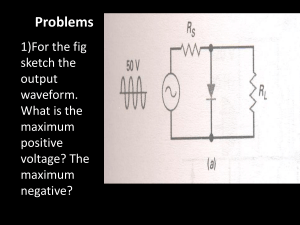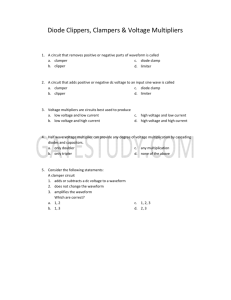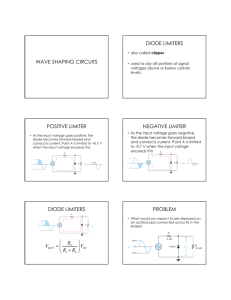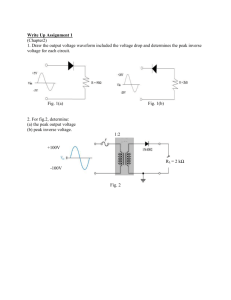ASSIGNMENT
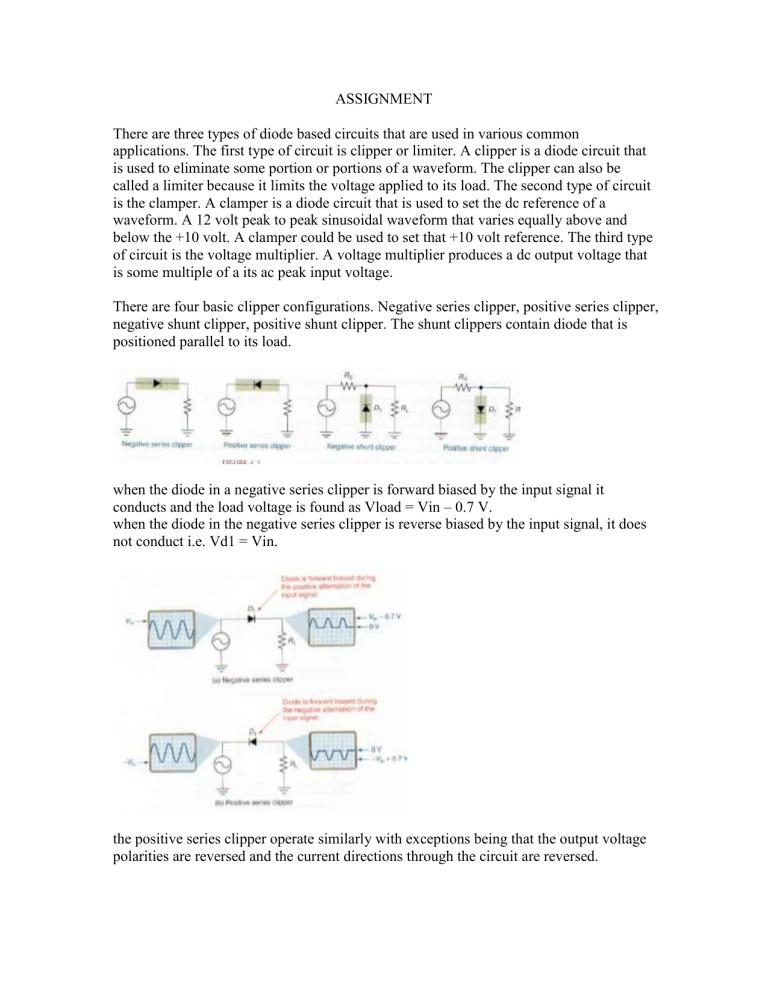
ASSIGNMENT
There are three types of diode based circuits that are used in various common applications. The first type of circuit is clipper or limiter. A clipper is a diode circuit that is used to eliminate some portion or portions of a waveform. The clipper can also be called a limiter because it limits the voltage applied to its load. The second type of circuit is the clamper. A clamper is a diode circuit that is used to set the dc reference of a waveform. A 12 volt peak to peak sinusoidal waveform that varies equally above and below the +10 volt. A clamper could be used to set that +10 volt reference. The third type of circuit is the voltage multiplier. A voltage multiplier produces a dc output voltage that is some multiple of a its ac peak input voltage.
There are four basic clipper configurations. Negative series clipper, positive series clipper, negative shunt clipper, positive shunt clipper. The shunt clippers contain diode that is positioned parallel to its load. when the diode in a negative series clipper is forward biased by the input signal it conducts and the load voltage is found as Vload = Vin – 0.7 V. when the diode in the negative series clipper is reverse biased by the input signal, it does not conduct i.e. Vd1 = Vin. the positive series clipper operate similarly with exceptions being that the output voltage polarities are reversed and the current directions through the circuit are reversed.
The shunt clipper is in effect opposite to series clipper, the series clipper passes its input signal to the load when the diode is forward biased and blocks its input signal when the diode is reverse biased.
The shunt clipper passes its input signal to the load when the diode is reverse biased and shorts out its input signal when the diode is forward biased.
During the negative alternation of the input signal the diode in the negative shunt clipper is forward biased and conducts. With the diode conducting the voltage across the component equals the diode forward voltage Vf. Since the diode and load are in parallel
Vl also equals the diode forward voltage i.e. V load = - Vf.
Also, since the output side of the Rs is approximately – 0.7 v when the diode is forward biased the voltage across Rs is equal to the difference between Vin and the value of Vf i.e.
V rs = - Vin + 0.7 V when the diode is forward biased.
Clippers are used in various electronic systems. For example they can be used to alter the shape of a waveform and provide the circuit transient protection.
A clamper is a circuit designed to shift a waveform either above or below a given reference voltage without distorting the waveform. There are two kinds of clampers positive and negative clamper.
a positive clamper is a circuit that shifts an entire input signal above a d reference voltage.
For example when a 20 V peak to peak sine wave is applied to a positive clamper with a dc reference of 0 volts. The input and output waveforms have a value of 20 V peak to peak.
A negative clamper is a circuit that shifts an entire input signal below a dc reference voltage. For example when a 20 V peak to peak sine wave is applied to a negative clamper with a dc reference of 0 volts. The negative clamper shifted the entire waveform so that its positive peak value is approximately equal to the circuits dc reference voltage.
The clamper is similar to a shunt clipper, the difference is the added capacitor in the clamper.
Also the biased clampers allow a waveform to be shifted so that it falls above or below a dc reference othet than a 0 volt.
I n zener clamper zener diodes are used to set the dc reference voltages of the circuits. For example if a 10 volt zener is used the dc reference voltage is approximately
+ 10 volts. If a 10 volt zener is used the dc reference voltage for that circuit is approximately – 10 volts. during the positive alternation of the input the diode branch conducts clamping the positive peak to Vz + 0.7 v. during the negative alternation of the input D1 is reversed biased blocking conduction through the diode branch.
By preventing the zener forward conduction during the negative alternation of the input cycle D1 established the one way conduction needed for proper clamper operation.
Voltage miltipliers: a coltage multiplier provides a dc output voltage that is a multiple of its peak input voltage. Like a voltage doubler provides a dc output voltage that is twice its peak input voltage.
The half wave voltage doubler consists of two diodes and two capacitors. Electrolytic capacitors are normally used because of their high capacity ratings.
full wave voltage doubler closely resembles the half wave doubler. It contains two diodes and two capacitors. voltage triplers and voltage quadruplers are both variations on the basic half wave voltage doubler. Voltage tripler produces a dc output voltage that is three times its peak input voltage. Voltage quadrupler produces a dc output voltage that is four times its peak input voltage.
Clipper faults: the faults that normally occuer in series clippers are the same as those of the half wave rectifier. The following fault symptom relationships are those for the basic shunt clipper and the biased clipper.
Fault saymptoms
Rs open If the source is isolated from the load, the
D1 open
D1 shorted load voltage and current both drop to zero.
Clipping action is lost so the output waveform is nearly indentical in shape to the input waveform.
The symptoms are the same as those for Rs open because the full applied voltage is dropped across Rs. The shorted diode shorts out load.
Clamper faults: the following are the fault symptoms are those for the basic clamper.
Fault symptoms
C1 open The voltage source is isolate from the rest of the circuit so load voltage and current drop to zero.
C1 shorted
C1 leaky
D1 open
D1 shorted
The circuit resembles a shunt clipper without a current limiting resistor. Either the diode will be destroyed from excessive current or the signal source will be shorted to ground and damaged.
The capacitor attempts to charge but is not able to hold the charge for any period of time. This causes the dc reference of the output signal to change constantly. The waveform itself is also extremely distorted.
All clamping action is lost and the output waveform is centered around the 0 Volt.
The voltage source is shorted to ground by the short RC time constant of the capacitor and the shorted diode. The output from the voltage source is loaded down and the voltage source itself may be damaged.
Additional zener clamper faults: zener clampers can develop any of the following possible faults:
If D1 shorts the clamper will act as an unbiased clamper.
If D2 is shorted then the zener diode turns on during both alternations of the input waveform. The resultant waveform will be a very distorted output waveform.
There is a good possibility that both diodes in the zener clamper will be destroyed if either diode fails. So whenever there is a fault found the faulty diode is to be replaced.
Voltage multiplier faults:
To trouble shoot the voltage multiplier we must start by reading the voltage across the output filter capacitor. The voltage across the filter capacitor may help to isolate the area where the fault is located.
By measuring the voltages across the components and comparing them with the normal values we can have a good idea if the components are the problem. when testing the voltage multiplier we follow the following procedure:
Measure the voltage across the output capacitor.
Measure the voltage across any capacitor that lies in the charge path of an uncharged capacitor.
Continue the process until we find the uncharged capacitor that is closest to the source. Then test all the components in the charge path for that capacitor.
